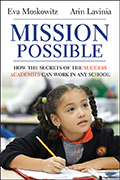Born to Rise: A Story of Children and Teachers Reaching Their Highest Potential
by Deborah Kenny
Harper, 2012, $25.99; 256 pages.
Mission Possible: How the Secrets of the Success Academies Can Work in Any School
by Eva Moskowitz and Arin Lavinia
Jossey-Bass, 2012, $27.95; 176 pages.
As reviewed by David Steiner
On page 87 of Mission Possible, the account by Eva Moskowitz and Arin Lavinia of the work of their charter schools, the reader is invited to watch a video of a book discussion in 1st grade. A detour to the included DVD is instructive: in this Harlem-based, lottery-selected public charter school, we see a 1st-grade classroom that challenges any in the country for the intellectual engagement of its students without any reliance on the regimented, direct instruction that the clichéd objections imagine dominate all successful charter schools. Faced with such examples, and the academic record of Moskowitz’s Success Academies, one’s first reaction should simply be applause. Having served (briefly) as a board member for one of the Success Academies, I know that such video clips are not cherry-picked: teachers in every classroom in every Academy school are expected to create such spaces of intense and demanding thinking and learning.
 A different but equally positive reaction is evoked by Deborah Kenny’s intensely personal account of the grit, resolve, and courage that led her to take the opportunity offered by the charter school movement and create a model school that her students were immensely lucky to attend. Her passion for bringing out the best in all who worked with her, her disarming throwaways (“it was the first five minutes of our first day, and already I’d made a mistake”), and her candid directness about necessary conditions for her work (“it is impossible to nurture a positive culture without the right to hire and fire at will”) make this an inspiring story.
A different but equally positive reaction is evoked by Deborah Kenny’s intensely personal account of the grit, resolve, and courage that led her to take the opportunity offered by the charter school movement and create a model school that her students were immensely lucky to attend. Her passion for bringing out the best in all who worked with her, her disarming throwaways (“it was the first five minutes of our first day, and already I’d made a mistake”), and her candid directness about necessary conditions for her work (“it is impossible to nurture a positive culture without the right to hire and fire at will”) make this an inspiring story.
Sharing boundless drive and self-discipline, and an equal commitment to proving that a child’s past is not her or his predetermined destination, Moskowitz and Kenny take justified pride in being mission-driven realists who, along with their handpicked colleagues, have radically recast the life chances of their students. But they have produced quite different books. Kenny’s more personal memoir does not reach her charter school until late in the narrative, and even then, the focus is squarely on forging a human culture, building a team whose members will go to the wall for their students, and for each other. For her, the disaster of American education is summed up by the line “we got here by disrespecting teachers.”
What Kenny means by respect is creating a culture of accountability for children’s learning that “enables freedom” and a freedom that “unleashes teacher passion.” Kenny explicitly eschews the cookbook vision of school reform: “Schools,” she writes, “are not products to be designed and replicated.” She goes on: “Every school in America has access to the same pedagogical ideas and methods we use. The problem is not lack of information but a lack of motivation engendered by the low accountability/low empowerment culture of our public schools.” Many of her sources of inspiration—Maxime Greene, Peter Drucker, Dennis Littky—are not your typical charter-school heroes. What connects them is not a method but a conviction that successful outcomes are all about people learning together, creating spaces of continual mutual feedback, encouragement, and empowerment. Kenny’s book is not and does not purport to be a how-to manual; it is a moving work about the power of well-placed determination matched to a political opportunity: the freedom through accountability that is the charter school.
Moskowitz and Lavinia set themselves a different task. Theirs is a self-proclaimed “how-to book.” As a result, the bar is in some sense higher: we expect to learn what the secrets are and how they can work. The answers in the book will enlighten readers who have heard about charter schools on the news but want to learn more. Moskowitz and Lavinia write at a relatively high level about effective techniques like the push to challenge students with the most rigorous and demanding material and instruction; the immediacy and constancy of granular feedback; the sharing of best practices; the focus on literacy instruction; the long school day and school year, including summer professional development for teachers; the constant coaching; and the agonizing care taken to choose each teacher from a vast pool of applicants. Each of these practices is standard at high-performing charters including KIPP, Uncommon Schools, and Achievement First, to take just three networks of such schools with which I am somewhat familiar.
What well-read educators and policymakers will want to know, and will not find in this book, is how it is that in New York City, in multiple instances, Success Academies, despite its astonishingly rapid growth as a school network, gets stronger academic results than even the top next-rung charter schools. Is it just that Moskowitz pushes even harder with even more rigor with even better-selected teachers on the good practices that the other charters are engaged in? If there are true secrets to the results from Success Academies, they are not on show here. A useful contrast in this respect is Paul Bambrik-Santoyo’s recently published Leverage Leadership: A Practical Guide to Building Exceptional Schools. The tools he lays out may or may not produce results at the level of the Success Academies, but those tools are in plain sight, in such unsecret forms as his “Observation Tracker.”
At the same time, these books will do nothing to silence the critics. There are, for example, no statistics on the percentage of ELL students in the schools, no numbers on the privately raised funds the schools put to use, and only cursory gestures, in Kenny’s book, to the controversy over students counseled out of or removed from these charter-school classrooms and to their teacher turnover rate.
In the end, the real contribution of these books lies neither in their appeals to the heart nor in the practices they catalogue, but in the moral condemnation each makes of our current education system. When Moskowitz argues that her practices can be adopted in any school, we are immediately tempted to say, Come on! Nine-hour days? Weeks of summer professional development? Responsiveness 24/7 to breakdowns in the classrooms, be it from noisy pipes or a single underwhelming lesson? Show me a public school system that could get there anytime soon.
But then we have to ask, why not? We have seen urban public schools successfully adopt many charter school “secrets,” including the nine-hour school day (e.g., United for Success Academies in Oakland); a rigorous, standard curriculum (e.g., the more than a dozen Chicago public schools that offer the International Baccalaureate); merit pay (e.g., the Washington, D.C., system); and the regular use of teacher video in professional development and evaluation (e.g., the Houston system, which was using video in this way as early as the 1980s).
Why have the results of the best-performing charter schools consistently eluded public school systems? The answer, unsurprisingly, has to do with the structures underlying public K–12 education. To bring to regular public schools the full panoply of successful charter-school practices we would need to rethink our labor practices, funding structures, reluctance to embrace a rigorous and specific curriculum, and all the other bêtes noires the national education conversation avoids or reduces to partisan caricatures.
If, rightly, we want to reject a zero-sum trade-off between our values, if what we need are a highly attractive long-term profession for successful teachers, accountability for student results, and a far more rigorous curriculum driving far higher learning outcomes for our students, are we willing to rethink the system from scratch and put everything on the table? If we cannot build a public school system on heroic individuals (and we surely cannot), how do we remake our school systems to make the standards Kenny and Moskowitz demand, and have largely achieved, the baseline of our public education? These books do not tackle these hard questions.
But no matter. One is left with the indictment and an urgent call to action, captured on page 136 of Kenny’s book: “‘This school’s a blessing!,’ exclaimed Jasmine’s grandmother when she found out they’d won the lottery. We hadn’t even opened our doors yet.”
David Steiner is dean of the School of Education at Hunter College and former commissioner of education for the State of New York.
This article appeared in the Spring 2013 issue of Education Next. Suggested citation format:
Steiner, D. (2013). It Can Be Done: Charter successes show how all schools might improve. Education Next, 13(2), 76-77.



